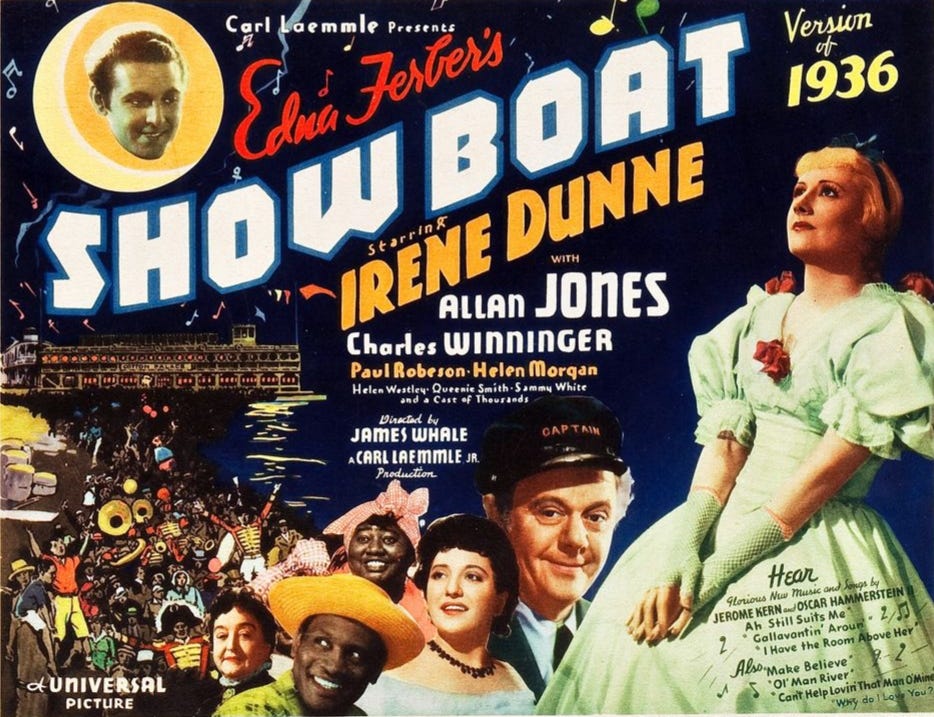Stream On: Musicals? It’s ‘Showboat’ or go home
I don’t like musicals, as a rule. ‘Show Boat’ (1936) is the exception to that rule.
Every musician knows that an arrangement of notes in time, even without lyrics, can evoke powerful emotions. In 1598 Jacopo Peri confirmed it with his musical dramatic presentation Dafne, considered the first opera. Still, opera, and its descendent, musical theater, are an acquired taste for some, including me. There’s good stuff there, but a lot of cheese, too. That said, excellence when it happens can’t be ignored, and here’s my favorite musical.
SHOW BOAT
/Amazon.com /Streaming /Faux Trailer /1936
Music is my first love, but “writing about music is like dancing about architecture” (Martin Mull). I can still weasel my way through musical drama, though, which is more than music. And James Whale’s 1936 film Show Boat, from Edna Ferber’s 1926 novel and Flo Ziegfield’s 1927 Broadway musical, one of the first topical musicals, is my favorite (and not least because of its music).
Mark Lubbock wrote about Show Boat, in The Complete Book of Light Opera, “Here we come to a completely new genre—the musical play as distinguished from musical comedy. Now, at long last, the play was the thing, and everything else was subservient to that play. Now, at last, came complete integration of song, humor and production numbers into a single and inextricable artistic entity. Here, finally, was a musical with a consistent and credible story line, authentic atmosphere and three-dimensional characters.”
In 1929 a silent film based on Edna Ferber’s novel was released. It was soon recut with a sound prologue, incorporating two songs from the stage musical (TCM’s reconstruction of surviving footage is on YouTube), but the head of Universal, Carl Laemmle, was dissatisfied and produced a sound version of the 1927 musical, not the novel, which went into production in 1935, with Charles Winninger, Sammy White and Helen Morgan from the 1927 production, Paul Robeson from the 1932 Broadway revival, and Irene Dunne, Allan Jones (A Night at the Opera) and Hattie McDaniel. James Whale (Frankenstein, The Bride of Frankenstein) directed.
It’s still in black and white, but the production, from the rotating cutouts of crowds carrying banners displaying the credits, to the sets, including the riverboat itself, has a festive and authentic feel (the action begins in the 1880’s on the Mississippi river). The music starts up as Captain Andy docks his riverboat at a small town and introduces its acts to the crowd. A romance is set up between Captain Andy’s innocent 18-year-old daughter Magnolia Hawks (Dunne) and Gaylord Ravenal (Jones), a handsome gambler. Magnolia’s friend, mixed-race singer Julie LaVerne (Morgan) is married to white Steve Baker (Donald Cook). Here’s where the drama begins: the marriage of LaVerne, who is passing for white, and Baker was still illegal in Mississippi in 1880. Their romance is contrasted with that of the 18-year-old and the gambler, and the waters are roiled for all of them—amid lovely comedy, such as an informal kitchen performance by Julie and Queenie (McDaniel), with Joe (Robeson), of “Can’t Help Lovin’ That Man of Mine,” in my opinion the centerpiece of the movie, after which pale young Magnolia indulges herself in one of the funkiest dances ever seen (watch it here). Joe grins, “Look at that girl shuffle!”
The music runs the gamut of comedy and drama, too: Paul Robeson’s incomparable performance as Joe, singing “Old Man River,” sets the scene for the drama:
There’s an ol’ man called the Mississippi; that’s the ol’ man that I’d like to be!
What does he care if the world’s got troubles? What does he care if the land ain’t free?
Frank S. Nugent, in the May 15, 1936 issue of The New York Times, used words like “excellent,” “best,” and “finest” to describe the film when it opened at The Radio City Music Hall. He wrote, “We have reason to be grateful to Hollywood this morning, for it has restored to us Edna Ferber’s Mississippi River classic, ‘Show Boat.’”
But this version also came close to being lost: it was withdrawn from circulation in the 1940s, after MGM, which wanted to remake the film, bought the rights (and all prints) from Universal. Paul Robeson was blacklisted by the House Un-American Activities Committee and this movie, among others, appeared to be a goner.
MGM’s remake (streaming here), released in the summer of 1951 with Kathryn Grayson and Howard Keel in the leading roles, is worth a watch, spectacle-wise: the very first screens with the credits are a riot of Technicolor, and the river long-shots (which might be matte paintings) are beautiful, if over-lit, like the rest of the film. I don’t believe a shadow can be seen during the entire run time, although I do think I saw some colors that defy nature. It doesn’t remind me of the book at all, and bless his heart, but William Warfield, as Joe, can’t seriously touch Paul Robeson, nor can Ava Gardner (whose singing voice was dubbed) match Helen Morgan. Howard Keel, as Gaylord Ravenel, annoys me, although Kathryn Grayson, as Magnolia, approached Irene Dunn’s innocence and had a lovely coloratura soprano voice.
James Whale’s 1936 version returned in 1983, on cable television, and a few years later, on PBS. It was made available on VHS beginning in 1990, and in 2014, a restoration of the film became available on DVD in the U.S. as part of Warner Home Video’s Archive Collection line. I own that one and still watch it on occasion. Show Boat (1936) is not only my favorite musical; it’s one of my favorite movies.
Pete Hummers is a participant in the Amazon Services LLC Associates Program, an affiliate advertising program designed to earn fees by linking Amazon.com and affiliate sites. This adds nothing to Amazon’s prices.




